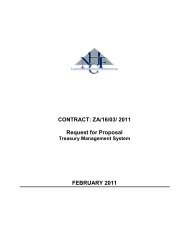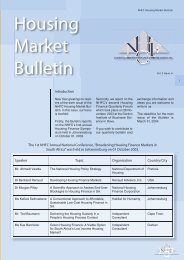housing - National Housing Finance Corporation
housing - National Housing Finance Corporation
housing - National Housing Finance Corporation
You also want an ePaper? Increase the reach of your titles
YUMPU automatically turns print PDFs into web optimized ePapers that Google loves.
GROUP ACCOUNTING POLICIES CONTINUED<br />
2. BASIS OF PREPARATION (continued)<br />
Financial assets at fair value through profit and loss<br />
Financial assets classified as held for trading are included in the category “financial assets at fair value through<br />
profit or loss”. Financial assets are classified as held for trading if they are acquired for the purposes of selling in<br />
the near term. Gains or losses on investments held for trading are recognised in income.<br />
Held-to-maturity investments<br />
Non-derivative financial assets with fixed or determinable payments and fixed maturity are classified as held-tomaturity<br />
when the Group has the positive intention and ability to hold to maturity. Investments intended to be held<br />
for an undefined period are not included in this classification. Other long-term investments that are intended to be<br />
held to maturity, such as bonds, are subsequently measured at amortised cost. This cost is computed at the amount<br />
initially recognised minus principal repayments, plus or minus the cumulative amortisation using the effective<br />
interest method of any difference between the initially recognised amount and the maturity amount.<br />
This calculation includes all fees received between parties to the contract that are an integral part of the effective<br />
interest rate, transaction costs and all other premium and discounts. For investment carried at amortised cost, gains<br />
and losses are recognised in income when the investments are derecognised or impaired, as well as through the<br />
amortisation process.<br />
Loans and advances<br />
Loans and advances are non-derivative financial assets with fixed or determinable payment that are not quoted in<br />
an active market. Such assets are carried at amortised cost using the effective-interest method. Gains and losses<br />
are recognised in income when the loans and advances are derecognised or impaired, as well as through the<br />
amortisation process.<br />
Available-for-sale financial assets<br />
Available-for-sale financial assets are those non-derivative financial assets that are designated as available-for-sale<br />
or are not classified in any of the three preceding categories. After initial recognition, available-for-sale financial<br />
assets are measured at fair value with gains or losses being recognised as a separate component of equity until<br />
the investment is derecognised or until the investment is determined to be impaired, at which time the cumulative<br />
gain or loss previously reported in equity is included in the income statement.<br />
The fair value of investments that are actively traded in organised financial markets is determined by reference to<br />
quoted market bid price at the close of business on the balance sheet date. For investments where there is no<br />
active market, fair value is determined using valuation techniques. Such techniques include using recent arm’s<br />
length market transaction; reference to the current market value of another instrument, which is substantially the<br />
same; discounted cash flow analysis and option pricing models.<br />
Trade and other receivables<br />
Trade and other receivables are recognised and carried at original invoice amount less an allowance for any<br />
uncollectible amounts. Provision is made when there is objective evidence that the Group will not be able to<br />
collect the debts. Bad debts are written off when identified. Short-term receivables are not discounted unless the<br />
effect is material.<br />
34 NHFC ANNUAL REPORT 2006






